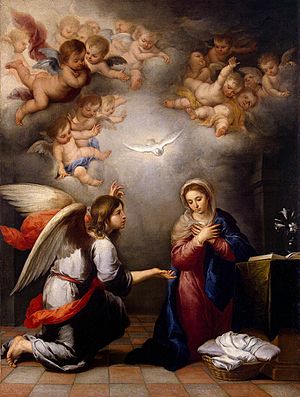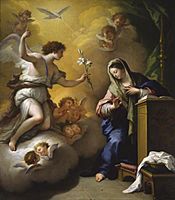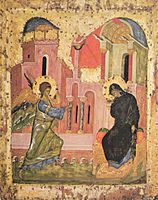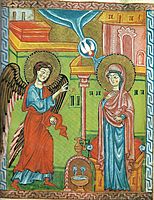Annunciation facts for kids
The Annunciation is a special event celebrated by Christians. It's about the angel Gabriel telling Mary that she would become the mother of Jesus Christ. This was a miracle because Mary was a virgin. Gabriel told her that her son would be called Jesus, which means "God is salvation." This event is seen as the start of Jesus becoming human.
The Bible says this happened when Mary's cousin, Elizabeth, was six months pregnant with John the Baptist. Many Christians celebrate the Annunciation on March 25th. This date is about nine months before Christmas, which is when Jesus's birthday is celebrated.
The Annunciation is a very popular subject in Christian art, especially in the Middle Ages and Renaissance. Sometimes, a painting or sculpture of this event is simply called an "Annunciation."
Contents
The Story in the Bible
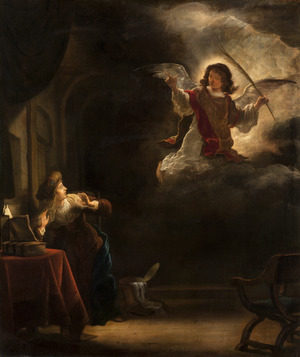
The main story of the Annunciation is found in the Bible in the book of Luke, chapter 1, verses 26–38.
- The angel Gabriel was sent by God to Nazareth, a town in Galilee.
- He went to a young woman named Mary, who was engaged to a man named Joseph.
- Gabriel greeted Mary, saying, "Greetings, you who are highly favored! The Lord is with you."
- Mary was confused and worried by his words.
- The angel told her not to be afraid. He said she had found favor with God.
- He explained that she would become pregnant and have a son, and she should name him Jesus.
- Gabriel said Jesus would be great and called the Son of the Most High God. He would rule forever.
- Mary asked how this could happen since she was a virgin.
- Gabriel explained that the Holy Spirit would come upon her. Her son would be called the Son of God.
- He also told her that her older cousin Elizabeth was also pregnant, even though she was old. This showed that nothing is impossible with God.
- Mary humbly replied, "I am the Lord's servant. May your word to me be fulfilled."
- After this, the angel left her.
The angel Gabriel's greeting to Mary is the first part of a famous prayer called the Hail Mary.
There is also a shorter story about the Annunciation given to Joseph in the book of Matthew, chapter 1, verses 18–23.
- Mary was found to be pregnant by the Holy Spirit before she and Joseph were married.
- Joseph, being a good man, planned to quietly end their engagement. He didn't want to shame her publicly.
- But an angel appeared to him in a dream. The angel told Joseph not to be afraid to marry Mary.
- The angel explained that the child in her was from the Holy Spirit.
- He said Mary would have a son, and Joseph should name him Jesus. This is because Jesus would save his people from their sins.
- The angel also said this happened to fulfill what God had said through a prophet: "The virgin will conceive and give birth to a son, and they will call him Immanuel" (which means "God with us").
The Annunciation in the Quran
The Annunciation is also mentioned in the Quran, the holy book of Islam.
In Surah Al-Imran (The Family of Imran), verses 45–51, it says:
- "Behold! the angels said: 'O Mary! God giveth thee glad tidings of a Word from Him: his name will be Christ Jesus, the son of Mary, held in honour in this world and the Hereafter and of (the company of) those nearest to God;'"
The story is also found in Surah Maryam (Mary), verses 16–26.
Eastern Christian Traditions
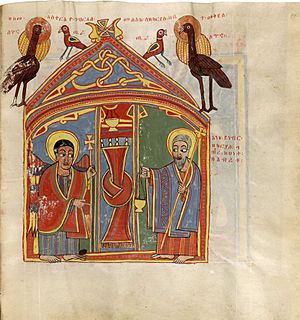
In Eastern Orthodox and Eastern Catholic traditions, the Feast of the Annunciation is one of the twelve most important holidays of the year. It is celebrated on March 25th. Some churches use an older calendar, so March 25th for them falls on April 7th on our modern calendar.
A traditional hymn for this feast says:
Today is the beginning of our salvation,
And the revelation of the eternal mystery!
The Son of God becomes the Son of the Virgin
As Gabriel announces the coming of Grace.
Together with him let us cry to the Theotokos:
"Rejoice, O Full of Grace, the Lord is with you!"
The Annunciation is so important because it marks the start of Jesus becoming human. Because of this, a special church service called the Divine Liturgy is always held on this day. Even if it falls on Good Friday, a very solemn day, the liturgy is still celebrated.
Churches Marking the Annunciation Site
Both Catholic and Eastern Orthodox Churches believe the Annunciation happened in Nazareth. However, they have slightly different ideas about the exact spot.
- Catholic tradition says it happened in Mary's home. The Basilica of the Annunciation marks this spot.
- Eastern Orthodox tradition believes it happened at the town well. The Greek Orthodox Church of the Annunciation marks that location.
Feast Day
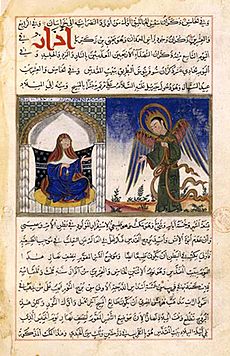
The Feast of the Annunciation is usually celebrated on March 25th. In the Catholic Church, Anglican, and Lutheran churches, the date might be moved if it falls during Holy Week or Easter Week, or on a Sunday.
However, Eastern Orthodox and Eastern Catholic Churches do not move the feast. They have special services that combine the Annunciation celebration with other holidays if they fall on the same day.
March 25th is also a national holiday in Lebanon and is celebrated as Greek Independence Day.
Historically, March 25th was sometimes used as the start of the new year in many Christian countries. This was because it was seen as the day when God's grace began with Jesus becoming human. In England, the Annunciation was known as Lady Day. Lady Day marked the start of the English new year until 1752.
The Annunciation in Christian Art
The Annunciation has been one of the most popular subjects for Christian art. The oldest known painting of the Annunciation is a fresco from the 4th century in the Priscilla catacomb.
Artists from both Eastern and Western Christianity have created many works about this event. It was especially popular during the Middle Ages and Renaissance. Almost all great artists have painted or sculpted the Annunciation. Mary and the angel Gabriel are often shown as symbols of purity and grace.
Famous artists who have depicted the Annunciation include Sandro Botticelli, Leonardo da Vinci, Caravaggio, Duccio, Jan van Eyck, and Murillo. Some well-known examples are:
- The mosaics by Pietro Cavallini in Rome (1291).
- The frescos by Giotto in Padua (1303).
- Domenico Ghirlandaio's fresco in Florence (1486).
- Donatello's gilded sculpture in Florence (1435).
-
The Annunciation by Paolo de Matteis, 1712, Saint Louis Art Museum, Saint Louis. The white lily in the angel's hand is symbolic of Mary's purity in Marian art.
Music
Many composers have created music about the Annunciation. For example, Johann Sebastian Bach wrote cantatas for the feast, such as Wie schön leuchtet der Morgenstern, BWV 1.
See also
 In Spanish: Anunciación para niños
In Spanish: Anunciación para niños
- Angelus
- Annunciade, religious order
- Annunciation of Ustyug
- Basilica of the Annunciation
- Chronology of Jesus
- Expectation of the Blessed Virgin Mary
- Greek Orthodox Church of the Annunciation, Nazareth
- Incarnation (Christianity)
- Order of the Most Holy Annunciation
- Roman Catholic Marian art
- Perpetual Virginity of Mary
Images for kids
-
Annunciation (c. 1472–1475), Uffizi, is thought to be Leonardo da Vinci's earliest complete work
-
Annunciation, work by unknown artist, c. 1420, Museu Nacional d'Art de Catalunya, Barcelona


